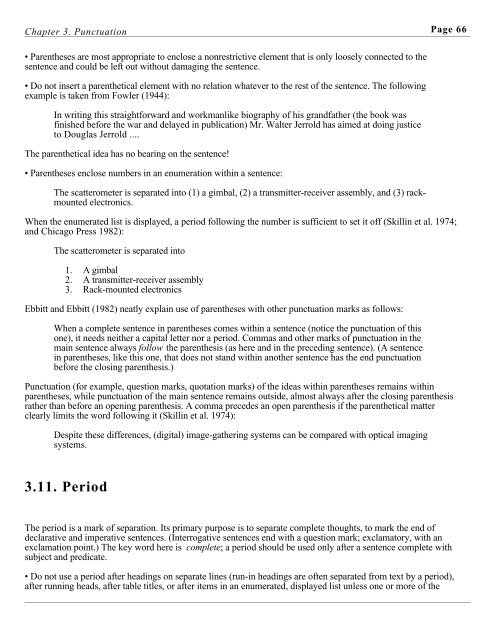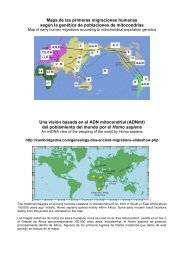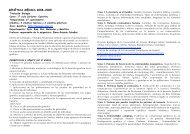Grammar, Punctuation and Capitalization - Handbook for Technical ...
Grammar, Punctuation and Capitalization - Handbook for Technical ...
Grammar, Punctuation and Capitalization - Handbook for Technical ...
Create successful ePaper yourself
Turn your PDF publications into a flip-book with our unique Google optimized e-Paper software.
Chapter 3. <strong>Punctuation</strong> Page 66• Parentheses are most appropriate to enclose a nonrestrictive element that is only loosely connected to thesentence <strong>and</strong> could be left out without damaging the sentence.• Do not insert a parenthetical element with no relation whatever to the rest of the sentence. The followingexample is taken from Fowler (1944):In writing this straight<strong>for</strong>ward <strong>and</strong> workmanlike biography of his gr<strong>and</strong>father (the book wasfinished be<strong>for</strong>e the war <strong>and</strong> delayed in publication) Mr. Walter Jerrold has aimed at doing justiceto Douglas Jerrold ....The parenthetical idea has no bearing on the sentence!• Parentheses enclose numbers in an enumeration within a sentence:The scatterometer is separated into (1) a gimbal, (2) a transmitter-receiver assembly, <strong>and</strong> (3) rackmountedelectronics.When the enumerated list is displayed, a period following the number is sufficient to set it off (Skillin et al. 1974;<strong>and</strong> Chicago Press 1982):The scatterometer is separated into1.2.3.A gimbalA transmitter-receiver assemblyRack-mounted electronicsEbbitt <strong>and</strong> Ebbitt (1982) neatly explain use of parentheses with other punctuation marks as follows:When a complete sentence in parentheses comes within a sentence (notice the punctuation of thisone), it needs neither a capital letter nor a period. Commas <strong>and</strong> other marks of punctuation in themain sentence always follow the parenthesis (as here <strong>and</strong> in the preceding sentence). (A sentencein parentheses, like this one, that does not st<strong>and</strong> within another sentence has the end punctuationbe<strong>for</strong>e the closing parenthesis.)<strong>Punctuation</strong> (<strong>for</strong> example, question marks, quotation marks) of the ideas within parentheses remains withinparentheses, while punctuation of the main sentence remains outside, almost always after the closing parenthesisrather than be<strong>for</strong>e an opening parenthesis. A comma precedes an open parenthesis if the parenthetical matterclearly limits the word following it (Skillin et al. 1974):Despite these differences, (digital) image-gathering systems can be compared with optical imagingsystems.3.11. PeriodThe period is a mark of separation. Its primary purpose is to separate complete thoughts, to mark the end ofdeclarative <strong>and</strong> imperative sentences. (Interrogative sentences end with a question mark; exclamatory, with anexclamation point.) The key word here is complete; a period should be used only after a sentence complete withsubject <strong>and</strong> predicate.• Do not use a period after headings on separate lines (run-in headings are often separated from text by a period),after running heads, after table titles, or after items in an enumerated, displayed list unless one or more of the






